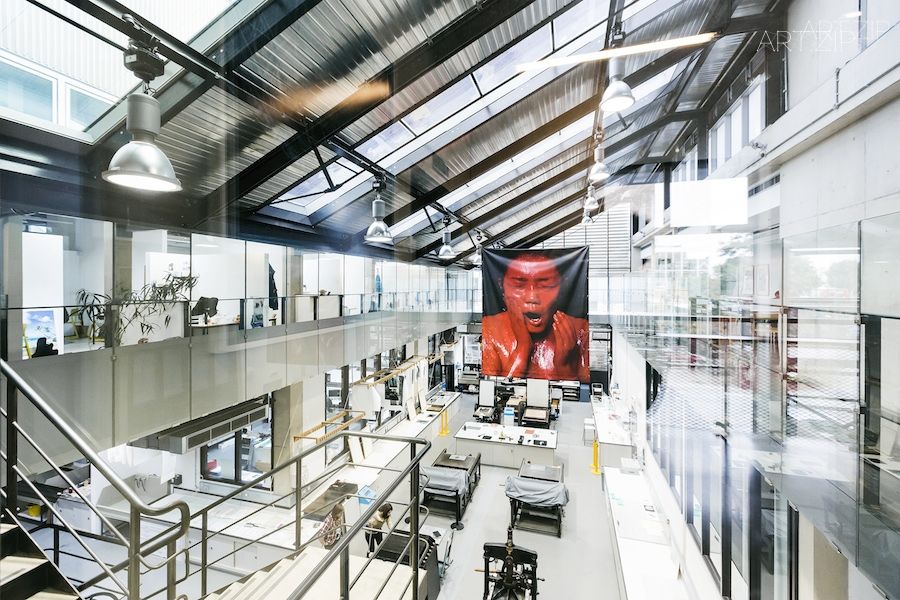
Interview with Professor Jo Stockham
Head of Printmaking at the Royal College of Art
專訪皇家藝術學院版畫專業課程主任
喬·斯托克姆
.
.
Jo Stockham has been Professor and Head of the Printmaking programme since 2008. She began working at the Royal College of Art in 1993 as a visiting lecturer in Painting, Sculpture and Printmaking. Her background in teaching sculpture and architecture and running gallery-based workshops and talks contributes to her passion for the interrelatedness of making work and creating spaces for discussion.
自2008年起喬·斯托克姆就在皇家藝術學院擔任版畫專業的課程主任和教授。她從1993年開始在皇家藝術學院教學,作為繪畫、雕塑和版畫專業課程的客座講師。她曾經從事關於雕塑和建築方面的教學工作,也組織工作坊和講座項目來探索創作和討論之間的關係。
,
.
ART.ZIP: Would you please give us a brief introduction about yourself and your programme?
JS: This is my fourth year of running the Printmaking programme. Before doing this, I was working across the school two days a week, and running a sculpture course at another college, because I was trained as a painter before I did an MA in Sculpture. When I was doing my MA, I was making a lot of prints, so I was doing both things alongside each other. Then I worked as an artist for many years, mainly doing commissions for site-specific installations, often using the history of site. I have always worked in a very mixed-media way.
I began to work full time because there are things in the programme that I want to change and develop. I was trying to build a bridge between digital skills and older traditions of making images, to curate a creative space where students can find the value of both of those things, mix them together and work in all sorts of ways to complicate the categorisations of things. Printmaking, historically, was a craft-based discipline, meaning people were more involved in how things are made rather than why they might be made; it hasn’t been such conceptual area in a way.
A lot of people who work with print do so because they are very interested in the ideas of multiple copies or interested in how print-making evolves. It links to all sorts of other disciplines, because there is so much printed information, students use maps, medical information, pages from newspapers, media and the Internet. For me, that’s all part of printmaking, because you know anything printed has history that is tied to reprographics, tied to the way ideas that circulated the world, so it makes for a very rich, very interesting discipline. If you mix the craft side of things with the conceptual side of things, you have a very rich blend to work with, as well as a rich culture. As you know, there are fantastic traditions of print in China that are different from the traditional in Japan, India, Germany, etc. This is one of the good parts of having international students, that they often bring with them very different approaches of making images. This is great, because this forces them to learn from each other, and so it is very nice thing to do, as a part of the programme here. While it’s wonderful to have conversations, often here people’s language skills are different; we communicate by showing people how to do something. Image is the way visual artists communicate, so if you’re curious about the way images work culturally throughout the world, this is a space where people can make things and teach each other. We look for students who have a genuine passion for making things, who really want to learn, are committed, and who are prepared to take risks to unlearn things.
ART.ZIP: 您能給我們介紹一下您和這個課程的情況嗎?
JS: 我教這個版畫專業已經四年了,在此之前,我每週來學校兩次教不同的專業課程,同時也在別的院校教雕塑課程。我原來是繪畫專業的,後來讀了雕塑研究生課程,期間我做了許多版畫作品和雕塑作品。然後我做了很多年的全職藝術家,主要做特定場地的委託藝術項目,作品通常與當地歷史相關。此外,很多時候我都運用多種媒介來進行創作。
我開始全職教書是因為我希望改變并拓展課程內容。我希望把電子技術和傳統的製畫技術結合起來建立一種新的聯繫,從而塑造一個新的領域讓學生找到這些事物的價值所在,把它們融合在一起,通過各種方式來把互不相同的事物組織起來。從歷史上來看,版畫是一個以技術為基礎的學科,這意味著人們更關注如何製作東西而不是為甚麼這樣製作;它還沒被從觀念上來進行發展。
許多人願意製作版畫因為他們對作品的多版本性感興趣,或者對版畫的發展感興趣。這些都是與其他學科相關的,因為大量的信息可以從印刷品中獲得。學生們可以通過地圖、醫學資料、報紙、媒體和互聯網獲得大量的資訊內容。對我來說這都是版畫的表現形式,因為任何被印刷出來的東西都與印刷術、複印術的歷史有關,與觀念和想法如何傳遞到世界各地相關,所以這是一個非常豐富和有趣的學科。如果把技術和觀念結合在一起的話,你可以有很豐富的素材來進行探尋和創作。你也知道中國有著非常獨特的印刷傳統,它與日本、印度、德國都非常不一樣。有國際學生参与我们课程的好處就在于此,他們總會帶來不一樣的方式來製作圖片。這是很好的,因為這樣能夠促使學生之間互相學習,這是課程的一個重要部分。這裡的學生有著不同的語言,所以我們可以通过給別人展示製作过程來进行跨文化交流和溝通。圖像是視覺藝術家溝通的重要部分,如果你对圖像在不同文化背景下如何發揮作用感興趣的話,這裡是很好的一個地方,人們可以進行獨立創作和互相傳授製作技巧。我們找的是那些對創作有熱情的學生,那些渴望學習并為之奮鬥的學生,那些對未知事物感興趣并敢於挑戰的學生。


